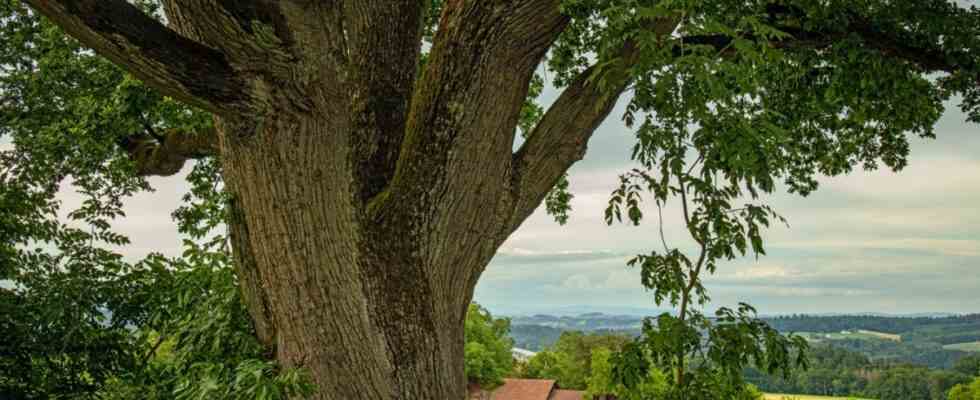The hunger oak of Giggenried in the district of Regen was a remarkable tree. Some called them plague ponds because it was said to have been planted in 1357 by one of the last survivors of the bubonic plague that was rampant at the time. A good hundred years ago, this oak reached a proud eleven meters in circumference. On January 3, 1957, on a windless day, the giant collapsed with a tremendous roar. A few hours earlier, the owner of the neighboring farm had noticed that the tree was making a strange creaking sound. When he fell, the giant mercifully spared the linden tree that had faithfully accompanied him for centuries, he fell on the other side. Even today, the crown branches of the linden tree are less strong on the side that used to face its neighbor.
The biologist Jürgen Schuller knows a great number of such tree stories. “Trees have fascinated me since I was a little boy,” he says. And trees were also the reason why he studied biology. When he began to tell tree stories online, they met with an unexpectedly high level of interest. “I must have filled a gap there,” he suspects, which motivated him to delve even more deeply into the mythology and history of old trees.
Some time ago he already published an illustrated book about special trees in the Upper Palatinate, a region which, with an estimated three billion trees, is one of the most tree-rich areas in Germany. Another volume is now available, dedicated to a series of fascinating trees in Lower Bavaria. And once again it causes great amazement what these few trees alone have to tell, which represent only a small part of the 26,400 tree species that exist worldwide. A good 50 of them are found in Bavaria, says Schuller, they have common names such as birch, maple, ash, beech, lime and oak, but there are also trees with a migration background, such as robinia, such as the gnarled specimen next to a chapel near Enzerweis in the district of Dingolfing-Landau.
Gnarled robinia near Enzerweis in the Dingolfing-Landau district.
(Photo: Jürgen Schuller/SüdOst Verlag / Battenberg Gietl Verlag)
Old wooden pear tree near Riedenburg in the Kelheim district.
(Photo: Jürgen Schuller/SüdOst Verlag / Battenberg Gietl Verlag)
In Lower Bavaria, too, says Schuller, there are certainly more tree species that have been introduced than there are native ones. The botanists have drawn a strict line. Trees introduced before the discovery of America in 1492 are considered native to Germany. The first robinia seedlings didn’t come here from Virginia until 1601, “so this tree species is a train roaster for science,” says Schuller. The situation is similar with that tulip tree in the Landshuter Hofgarten, which is characterized by its stately height and strange leaves. It is also of American origin and only came to European parks in the 17th century.
Schuller also lists old fruit trees in his new volume. Even if plum, pear and apple trees are already a hundred years old and even the largest, such as a wooden pear tree he documented near Riedenburg in the district of Kelheim, barely reach a third of the height of an oak.
Of course, the mighty oaks and linden trees also make a great impression in Lower Bavaria, some of which look back on an age of up to a thousand years and are entwined with the most adventurous stories. The famous thousand-year-old linden tree at the Halbmeile chapel near Deggendorf shines simply because of its magical location right on the edge of the forest, where it shelters an old chapel. It has a circumference of almost eight meters and hides a mysterious cave in its trunk. This offers space for three people, but one is occupied by a statue of Mary. An old place of execution is said to have been here, which explains why the area around the Linde was once feared as a place of spooks and dead lights.
Millennial linden tree at the half-mile chapel.
(Photo: Jürgen Schuller/SüdOst Verlag / Battenberg Gietl Verlag)
Hunger oak from Giggenried.
(Photo: Jürgen Schuller/SüdOst Verlag / Battenberg Gietl Verlag)
More than any other native tree species, old oaks provide valuable habitat for animals and plants. 400 species of insects, some of which are very rare, live exclusively from and on trees such as the many-armed pedunculate oak in Waidgasse near Rittsteig. With a circumference of more than 5.50 meters, it is considered the strongest tree in Passau. The 450-year-old oak tree is probably hollow in the core, but will not fall over as long as it still forms enough wood mass. Most recently, the crown still showed a rich green and full foliage even in dry conditions.
The currently thickest tree in Lower Bavaria is the 400-year-old Patzinger lime tree near Adlkofen in the district of Landshut with a trunk circumference of almost nine meters. Schuller suspects that this uniquely beautiful tree is a guide tree that showed travelers the way. You can guess what the old trees, which are particularly numerous in Lower Bavaria, could tell. Schuller estimates that around 400,000 trees older than 200 years grow in this region.
Jürgen Schuller, Fascinating Trees in Lower Bavaria, SüdOst Verlag, 168 pages, 29.90 euros.

